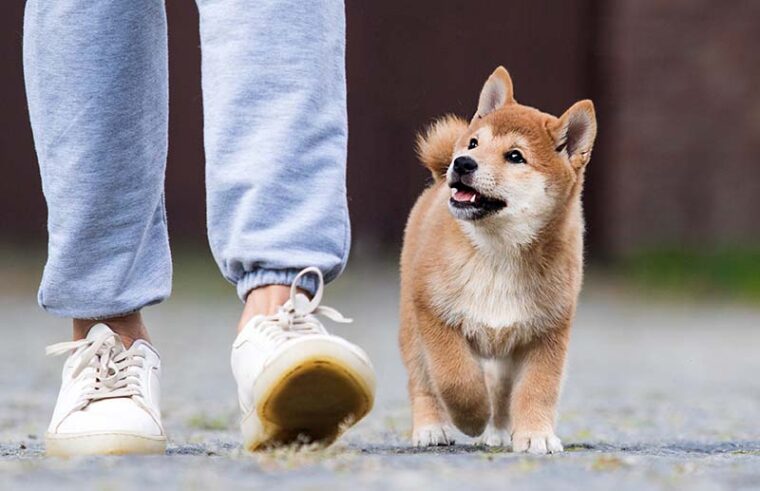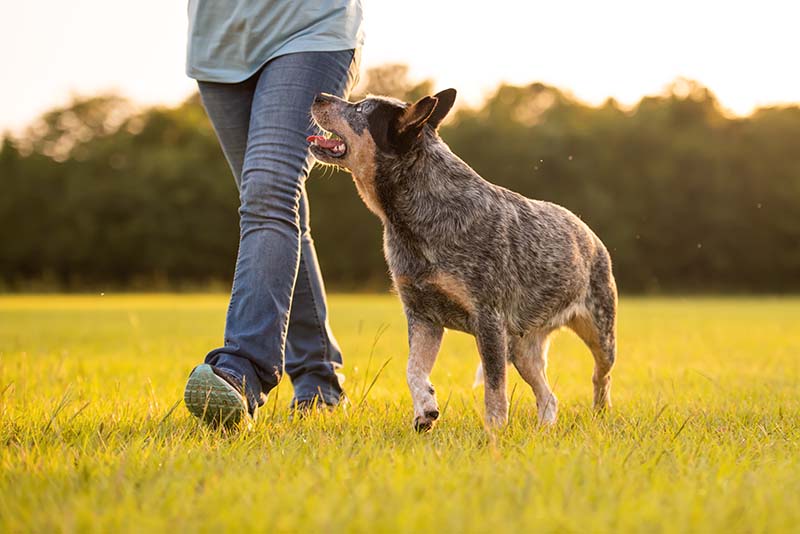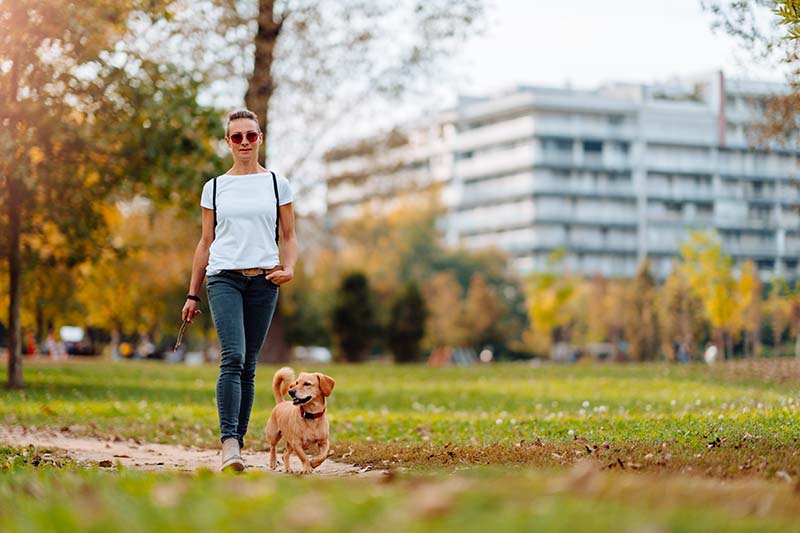
Knowing how to walk off-leash will open a whole new world for you and your pup! It will give your dog greater freedom on your walks, and you can take them with you to more places without worrying about them running off.
The thing is, off-leash walking is one of the more advanced skills that you can teach your pup. It builds on several commands and behaviors that dogs already know, so it’s important to be prepared with the right tools and training plan.
What Is Off-Leash Walking?
Off-leash walking doesn’t mean removing your dog’s leash and letting them run off wherever they want.
Instead, think of it as having an “invisible” leash. You still remain in full control of your dog. For instance, they will come, sit, and stay on command. They’ll keep their eyes on you instead of getting distracted by other people, animals, and objects—except this time, there’s no physical leash tying them to you.
Because of that, off-leash training requires exceptional trust and communication between you and your dog. It’s not an easy command to master, but it’s worth it.

Off-Leash Training: Tools You’ll Need
Got the basics down? Great! Now it’s time to get into the off-leash training itself. Here are some tools you’ll need.
Long Leash
Yes, you still need a leash when you first start off-leash training. You need to give them freedom gradually until you are confident that they will obey commands, no matter how much of a distraction there is.
Get the longest leash you can, preferably 10 to 15 feet in length. Don’t use any retractable leashes since they don’t give you much control.
Extra-Tasty Treats
Your pup needs to learn that coming back to you is the most rewarding thing they can do. Regular treats won’t cut it when there are countless things they can explore off-leash.
Use the smelliest, most delicious treats you have. Try boiled chicken, hotdogs, cheese, or anything else your pup loves and doesn’t get often.
Target Stick or Similar Training Tool
A target stick will make it easier for you to give clear signals to your pup, such as pointing them in the right direction or getting their attention. You can use a tennis ball on the end of a long stick, a pointer, or any other type of marker you like.
High-Value Toys
To make sure your pup is happy and engaged while they are off-leash, you need to have some super fun toys with you. Something like a flirt pole or a tug toy is perfect for this purpose.
How to Train Your Dog to Be Off-Leash: Step-by-Step

If you’re confident that you and your pup are ready, it’s time to begin! Remember: off-leash training involves elements of recall, heel, loose-leash, and other obedience training. Follow these steps:
1. Choose a Secure and Familiar Space
Select a spot where there’s no risk of your pup running off. No busy roads or dog parks just yet, please! A fenced-in backyard or even your basement are great spots. Make sure it’s somewhere they’re already familiar with, as this will reduce any anxiety your pup may have about being off-leash.
2. Start With the Long Leash
Attach the long leash to their collar and give them some freedom to roam around while still being able to control their movements. During this time, practice recall, heel, and loose-leash commands. Increase the distance until the long leash is maxed out and they reliably respond.
3. Remove the Leash Altogether
Once your pup is confidently following commands on the long leash, it’s time to take the next step: remove the leash entirely. Again, make sure you’re in a contained environment with minimal stimuli. You don’t want to overwhelm your dog.
This part is more of the same: call them back, make them heel, and practice other obedience commands off-leash.
4. Introduce Distractions
When your pup is a pro at responding off-leash, you can introduce distractions but still in a contained space you control. Add one distraction at a time, such as having another person there or playing fetch. Increase the complexity as your pup becomes more comfortable. Try bringing in another dog, letting more people join, or playing a game with multiple toys.

5. Gradually Increase Freedom
Now it’s time to take things outside – but not just to the park yet! For example, find an empty parking lot or a quiet street. Keep the off-leash training sessions in these locations short, starting from 10 minutes at a time, and work your way up.
Why? Because you want to set your dog up for success. Letting them loose for an hour before they’re ready is only going to set you both back. Instead, start small and build up as their reliability increases.
6. Proofing
Proofing refers to taking all the training that you’ve done and making sure your pup is able to show reliable behaviors even in different environments. This is one of the most critical parts of training any skill or command.
When it comes to proofing off-leash training, think about all the places and situations you want your pup to be able to handle off-leash, such as:
Once your pup can reliably and consistently respond off-leash in all these scenarios and more, you can be confident that they are a pro. Now you can let them off-leash anywhere with peace of mind that they’ll come back when called!

Master These Commands Before Off-Leash Training
Successful off-leash training requires your pup to have a good foundation of basic commands. That means they should be able to reliably respond to the following:
Come
Recall is by far the most important command for off-leash training. Your pup should come to you no matter what distractions they encounter or how far away they are.
It’s more than just getting them to come back. It’s key to safety, both for your dog and anyone else around them. Spend plenty of time teaching this command and keep it fresh with different practice scenarios.

Sit and Stay
Another basic skill for off-leash training is your dog’s ability to sit and stay. They should be able to drop into a sit-stay position and remain in that spot until you give them a release command. More importantly, they should be able to do this from afar and not just when they are close to you.
Leave It
This command is all about impulse control. An off-leash dog will encounter various items on the way, from food and enticing smells to people and animals. To prevent them from getting too curious or trying to go after something, they need to be able to recognize and obey the ‘leave it’ command.
Heel
An important extension of off-leash training is teaching your pup to walk beside you while they are off-leash. This is called ‘heeling’, and it’s something that many dogs struggle with. A reliable heel will ensure that your dog stays near when you need them to.

Look at Me
Your dog’s focus is essentially the “leash” that keeps them connected to you when off-leash. Being able to get their attention and direct it back towards you—no matter where they are or what’s happening around them—is a crucial element of off-leash training.
Loose-Leash Walking
Before they can go off-leash, your dog should be able to walk nicely on a leash. Loose-leash walking is the precursor to off-leash walking. It operates on a similar concept: a dog voluntarily staying close to you without you having to force them in any way.
Drop It
The “drop it” command is related to the “leave it” command, but they’re different. “Leave it” is used to tell your dog not to go after something. “Drop it,” on the other hand, teaches them to drop an item they’re already holding in their mouth.
This command, along with recall and leave it, can quite literally save their lives. If your dog ever happens to pick up something dangerous, such as a discarded glass bottle or a rotting animal carcass, “drop it” can prevent them from getting hurt.
These commands are all part of basic obedience training. We recommend focusing on these first before you move on to off-leash training. Otherwise, you and your dog will be in for a frustrating or even dangerous experience.

Conclusion
Off-leash training is a long journey, and it requires a strong foundation of basic commands, trust, and two-way communication between you and your dog.
Despite this, approach it just like any other command. Keep it fun, reward and praise your dog abundantly, and never punish them for mistakes. Be patient with yourself as well; you’re both learning something new! With love and consistency, you’ll soon be the proud owner of a dog who can walk, run, and explore off the leash.
Featured Image Credit: Happy monkey, Shutterstock








